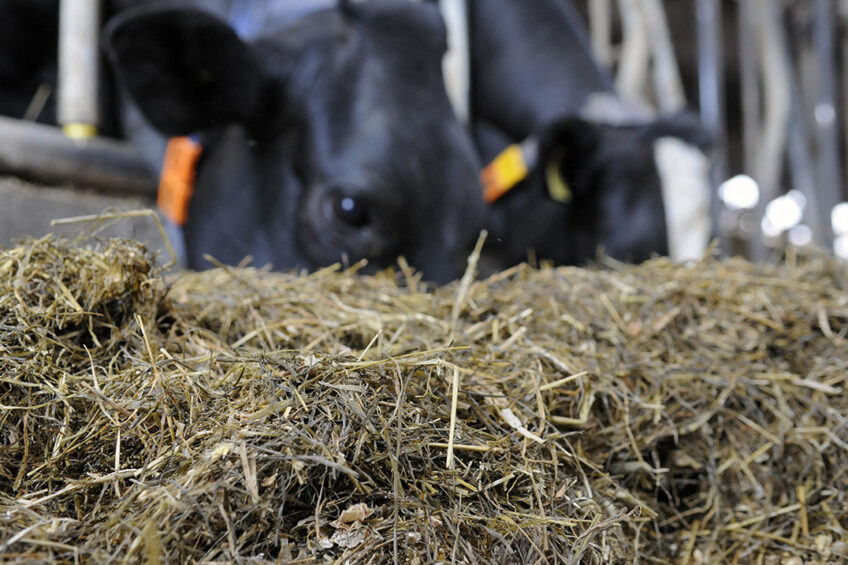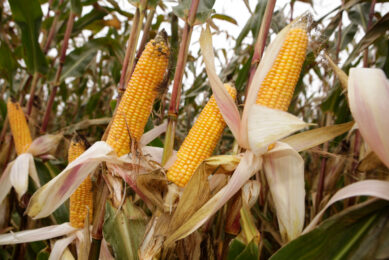Effective control of aflatoxins in dairy cows

Mycotoxins are secondary metabolites produced by fungi, which can multiply and grow fast in a variety of feedstuffs and stages of crop production, especially in warm and humid conditions often observed in southern EU countries.
Why are aflatoxins a real risk?
Because weather conditions cannot be controlled, accumulation of mycotoxins is more frequent on the fields making the prior-harvest period very important. Mycotoxins can also grow during transporting and storing feedstuffs at the farm premises. Farm feed silos are an ideal environment to grow moulds as condensation silently occurs from the temperature difference between night and day intervals.
Mycotoxins remain a concern in the animal feed
With the average temperature following an upward trend in the EU, mycotoxins remain a concern for the animal feed industry. Portions of feed contaminated with mycotoxins can be the carrying agent for ingested mycotoxins in the digestive tract of animals.
The most critical mycotoxins known to date and those that are a financial threat to dairy cattle include mainly aflatoxins. Others like deoxynivalenol, fumonisins, ochratoxin A, zearalenone, T-2 toxin and ergot alkaloids, still cause numerous health issues – their financial impact is less visible for farmers.
Human health at risk
Contamination of feedstuffs with Aflatoxin B1 (AFB1) metabolite of Aspergillus sp. (A. Flavus and A. parasiticus) is of high concern for human health as AFB1 transformed into AFM1 in the rumen, passes to milk and thereafter to dairy products (raw milk > cheeses etc.). AFM1 is very resistant to thermal procedures like pasteurisation and freezing, common practices in dairies. Aflatoxins have several health consequences for humans linked with carcinogenesis (bio-activation and production of Aflatoxicol in the rumen) liver cancer and birth defects.
Regulatory limits
The EU regulatory limits are very strict with regulation 1881/2006 setting a maximum limit of 0.05 μg kg-1 for AFM1 in raw milk, heat-treated milk and milk for the manufacture of milk-based products (EC 2006). In small ruminants and especially dairy sheep and goats, aflatoxins result in hepatic toxicosis, nephrotic lesions (intensified with bacterial infection of Clostridium perfringens type D), mineral deficiencies and, in some cases, vaccination failures.
Economic impact
The economic impact affects the total supply chain from crop production to dairy products with farmers having severe market losses associated with the rejection of contaminated milk. The cost per litre of milk produced significantly increases! Animal health and welfare depression leads in some cases to death, especially in calves that are much more sensitive (even at low levels). Although there are different levels of tolerance per toxin for dairy cattle and depending on the stage of production, multiple moulds and toxin contamination of grains and roughages increase the exposure to toxins for dairy cattle.
Immunity, gut health and oxidative stress
The toxins depress immunity and gut health. The integrity of epithelial cells in the gut can maintain homeostasis and prevent infection from pathogenic bacteria. Mycotoxins have a negative impact on the intestinal mucus, secretion of antimicrobial peptides, chemokines and cytokines. They then great imbalances between intestinal epithelial cells, microbiota and local immune cells, which is the regulatory mechanism to provoke toxins entering the bloodstream. They also increase oxidative stress, which is much more critical for cows under heat stress conditions. Direct loss of appetite and low reproductive performance (mainly because of embryotoxicity) are also symptoms of mycotoxicosis.
The benefit of a functional rumen
While ruminants are considered effective against mycotoxicosis because of the ability of the rumen to degrade and inactivate mycotoxins, at the same the consumption of roughages, including hays and silages, make up at least 40-45% of DMI. Roughages are colonised with acid-tolerant yeasts and fungi. Ingesting rumen with high levels of numerous different moulds and mycotoxins depresses rumen fermentability and NDF degradability. A domino effect of metabolic imbalances starts from reduced fatty acids production which then progressively lead to subclinical acidosis. A multiplication of metabolic and non-metabolic disturbances including lameness, low fertility, subclinical mastitis and reduced milk production with higher somatic cell count, occurs.
Mycotoxin risk management programme
Because aflatoxins exist during pre and post-harvest periods, storage, transport, processing and handling steps of several feedstuffs, an effective mycotoxin risk management programme including critical control points from field crop production through to farm level and dairies seems to be the only way to fully control an outbreak.
On a farm level, I would recommend that farmers improve hygiene, keep grains and forages data records and introduce mycotoxin inhibitors as a standard practice. This could be a very effective approach to improve aflatoxins control and detoxification of feed offered. Chemical detoxification is applied in some countries, but this practice is not allowed in Europe. Post-harvest go-to solutions are the use of sorbet ingredients (adsorbents) to absorb several toxins through the gastrointestinal tract (GI). Adsorbent effectiveness on several pH values of GI and its physical structure is the key properties to judge whether is suitable or not. Aluminosilicates, bentonites, zeolites, clinoptilolites and other clay mineral adsorbents are very effective against aflatoxins but their weak point is that they can absorb other molecules with high nutritional value such as vitamins. Always, reformulate on mutual use of such additives!
Clay mineral combinations with YCW nutrition
I suggest the use of different combinations of clay minerals that effectively bind mycotoxins but in addition to that, the use of yeast fractions may increase effectiveness due to its postbiotic effect in the gut. A yeast cell wall (YCW) is structured by mannoproteins, b-glucans and glycoproteins. YCWs coming from primary fermentation aim for a probiotic effect. On the other hand, having a prebiotic effect, inactivated yeast from the secondary fermentation process (brewery or bioethanol) may seem like a more convenient solution.
Although it still remains a by-product with often batch-to-batch variations, modern optimised acid hydrolysis methods enrich yeast with soluble oligosaccharides and functional manno-oligosaccharides (MOS). Modern procedures increase the exposure of all the cell wall components including b-glucans to bacteria and immune cell receptors in the intestine. In my opinion, if such additives are combined in a way that reaches GI efficiently, it is likely that cows in the herd will be one step closer to binding toxins while promoting the probiotic and/or prebiotic effects.
Join 13,000+ subscribers
Subscribe to our newsletter to stay updated about all the need-to-know content in the dairy sector, two times a week.










